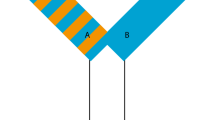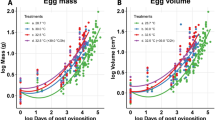Abstract
The embryos of egg-laying species are exposed to variable thermal regimes, which can influence not only the resultant hatchling’s morphology (e.g., size, sex) and performance (e.g., locomotor speed), but also its cognitive performance (learning ability). To clarify the proximate basis for this latter effect, we incubated eggs of the scincid lizard Bassiana duperreyi under simulated ‘hot’ and ‘cold’ natural nest temperatures to examine the effect of incubation temperature on the structure of the telencephalon region of the forebrain. Hatchlings from low-temperature incubation had larger telencephalons (both in absolute terms and relative to body size) and larger neurons in their medial cortices, whereas the medial cortices of hatchlings from high-temperature incubation had fewer neurons overall, but greater neuronal density, and more neurons in certain areas. These temperature-induced differences in B. duperreyi forebrain development are consistent with (and may explain) the disparities in learning ability between hatchlings from our two incubation treatments. The phenotypic plasticity of lizard telencephalon anatomy in response to incubation temperature presents exciting opportunities for studies on the evolutionary and developmental determinants of intelligence in vertebrates, but also offers a cautionary tale. Global climate changes, wrought by anthropogenic activities, may directly modify brain structure in reptiles.





Similar content being viewed by others
References
Amiel JJ, Shine R (2012) Hotter nests produce smarter young lizards. Biol Lett 8:372–374
Amiel JJ, Tingley R, Shine R (2011) Smart moves: effects of relative brain size on establishment success of invasive amphibians and reptiles. PLoS One 6:e18277
Amiel JJ, Lindström T, Shine R (2014) Egg-incubation effects generate positive correlations between size, speed and learning ability in young lizards. Anim Cogn 17:337–347
Butler AB (1980) Cytoarchitectonic and connectional organization of the lacertilian telencephalon with comments on vertebrate forebrain evolution. In: Ebbesson SOE (ed) Comparative neurology of the telencephalon. Plenum Press, New York, pp 297–329
Chittka L, Niven J (2009) Are bigger brains better? Curr Biol 19:R995–R1008
Clark BF, Noble DWA, Whiting MJ, Amiel JJ, Shine R (2014) Colour discrimination and associative learning in hatchling lizards incubated at ‘hot’ and ‘cold’ temperatures. Behav Ecol Sociobiol 68:239–247
Coomber P, Crews D, Gonzalez-Lima F (1997) Independent effects of incubation temperature and gonadal sex on the volume and metabolic capacity of brain nuclei in the leopard gecko (Eublepharis macularius), a lizard with temperature-dependent sex determination. J Comp Neurol 380:409–421
Crews D, Coomber P, Gonzalez-Lima F (1997) Effects of age and sociosexual experience on the morphology and metabolic capacity of brain nuclei in the leopard gecko (Eublepharis macularius), a lizard with temperature-dependent sex determination. Brain Res 758:169–179
Day LB, Crews D, Wilczynski W (1999a) Relative medial and dorsal cortex volume in relation to foraging ecology in congeneric lizards. Brain Behav Evol 54:314–322
Day LB, Crews D, Wilczynski W (1999b) Spatial and reversal learning in congeneric lizards with different foraging strategies. Anim Behav 57:393–407
Day LB, Crews D, Wilczynski W (2001) Effects of medial and dorsal cortex lesions on spatial memory in lizards. Behav Brain Res 118:27–42
Deeming D (2004) Post-hatching phenotypic effects of incubation in reptiles. In: Deeming D (ed) Reptilian incubation: environment, evolution and behaviour. Nottingham University Press, Nottingham, pp 229–251
Elphick MJ, Shine R (1998) Longterm effects of incubation temperatures on the morphology and locomotor performance of hatchling lizards (Bassiana duperreyi, Scincidae). Biol J Linn Soc 63:429–447
Harlow PS (1996) A harmless technique for sexing hatchling lizards. Herpetol Rev 27:71–72
Hayashi A, Nagaoka M, Yamada K, Ichitani Y, Miake Y, Okado N (1998) Maternal stress induces synaptic loss and developmental disabilities of offspring. Int J Dev Neurosci 16:209–216
Healy SD, Rowe C (2007) A critique of comparative studies of brain size. Proc Roy Soc London B 274:453–464
Herculano-Houzel S, Manger PR, Kaas JH (2014) Brain scaling in mammalian evolution as a consequence of concerted and mosaic changes in numbers of neurons and average neuronal cell size. Front Neuroanat 8:1–28
Holding ML, Frazier JA, Taylor EN, Strand CR (2012) Experimentally altered navigational demands induce changes in the cortical forebrain of free-ranging Northern Pacific Rattlesnakes (Crotalus o. oreganus). Brain Behav Evol 79:144–154
Jerison HJ, Barlow HB (1985) Animal intelligence as encephalization. Philos Trans R Soc B 308:21–35
Lefebvre L, Reader SM, Sol D (2004) Brains, innovations and evolution in birds and primates. Brain Behav Evol 63:233–246
Lemaire V, Koehl M, Le Moal M, Abrous D (2000) Prenatal stress produces learning deficits associated with an inhibition of neurogenesis in the hippocampus. Proc Natl Acad Sci USA 97:11032–11037
López J, Vargas J, Gómez Y, Salas C (2003) Spatial and non-spatial learning in turtles: the role of medial cortex. Behav Brain Res 143:109–120
Luders E, Narr KL, Thompson PM, Toga AW (2009) Neuroanatomical correlates of intelligence. Intelligence 37:156–163
Mader D (2006) Euthanasia. In: Mader D (ed) Reptile medicine and surgery, 2nd edn. Saunders Elsevier, St Louis, pp 564–568
Morgane PJ, Mokler DJ, Galler JR (2002) Effects of prenatal protein malnutrition on the hippocampal formation. Neurosci Biobehav Rev 26:471–483
Mouton PR (2011) Unbiased stereology: a concise guide. Johns Hopkins University Press, Baltimore
Northcutt RG (1978) Forebrain and midbrain organization in lizards and its phylogenetic significance. In: Greenberg N, MacLean PD (eds) Behaviour and neurology of lizards: an interdisciplinary colloquium. National Institute of Mental Health, Maryland, pp 11–64
Pfefferbaum A, Mathalon DH, Sullivan EV, Rawles JM, Zipursky RB, Lim KO (1994) A quantitative magnetic resonance imaging study of changes in brain morphology from infancy to late adulthood. Arch Neurol 51:874–887
Purves D, Lichtman JW (1985) Principles of neural development. Sinauer, Sunderland
Roth ED, Lutterschmidt WI, Wilson DA (2006) Relative medial and dorsal cortex volume in relation to sex differences in spatial ecology of a snake population. Brain Behav Evol 67:103–110
Sakata JT, Coomber P, Gonzalez-Lima F, Crews D (2000) Functional connectivity among limbic brain areas: differential effects of incubation temperature and gonadal sex in the leopard gecko, Eublepharis macularius. Brain Behav Evol 55:139–151
Shine R, Harlow PS (1996) Maternal manipulation of offspring phenotypes via nest-site selection in an oviparous lizard. Ecology 77:1808–1817
Telemeco RS, Elphick MJ, Shine R (2009) Nesting lizards (Bassiana duperreyi) compensate partly, but not completely, for climate change. Ecology 90:17–22
West MJ (2012) Basic stereology for biologists and neuroscientists. Cold Spring Harbor Laboratory Press, New York
White S, O’Reilly H, Frith U (2009) Big heads, small details and autism. Neuropsychologia 47:1274–1281
Acknowledgments
For funding, we thank the Australian Research Council and the Natural Sciences and Engineering Research Council of Canada. We thank Sanaz Maleki and Shanna Trollip (University of Sydney) for their guidance with histological preparations, and acknowledge Melanie Elphick, Breanna Chipney and Chris Chipney for technical assistance and Lainy Day (University of Mississippi), Ester Desfilis (Universitat de Lleida), Pau Carazo (University of Oxford) and Roger Pamphlett (University of Sydney) for sharing their expertise in neuroanatomy. Input from reviewers substantially improved the manuscript.
Author information
Authors and Affiliations
Corresponding author
Ethics declarations
Conflict of interest
The authors declare that they have no conflict of interest.
Ethical approval
All research was approved by the University of Sydney Animal Ethics Committee (L04/12-2010/3/5449). Collecting permits were provided by the ACT Government Territory and Municipal Services.
Additional information
This article is part of the Special Issue Animal cognition in a human-dominated world.
Rights and permissions
About this article
Cite this article
Amiel, J.J., Bao, S. & Shine, R. The effects of incubation temperature on the development of the cortical forebrain in a lizard. Anim Cogn 20, 117–125 (2017). https://doi.org/10.1007/s10071-016-0993-2
Received:
Revised:
Accepted:
Published:
Issue Date:
DOI: https://doi.org/10.1007/s10071-016-0993-2




